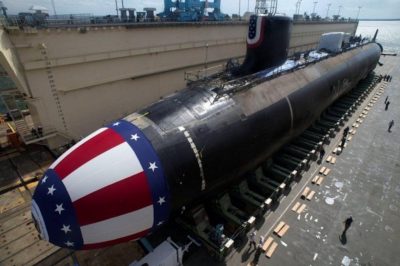US Worsens Security Crisis as Its Submarine Violates Russian Waters

All Global Research articles can be read in 51 languages by activating the “Translate Website” drop down menu on the top banner of our home page (Desktop version).
To receive Global Research’s Daily Newsletter (selected articles), click here.
Visit and follow us on Instagram at @globalresearch_crg.
***
On Saturday, February 12, military tensions between the West and Russia reached a new peak after the Russian Navy confirmed the sighting of an American submarine near the Kuril Islands, sailing in Russian waters without authorization. The submarine was detected by Russian observers during military exercises in the region and led Moscow to release a note discouraging the US government from this type of maneuver and reaffirming the Russian right to self-defense.
The sighting was made on Saturday morning, in the Urup region. The American Virginia-class submarine entered an area where routine military exercises were being operated by the Russian Pacific Fleet. When approached by the Russian Navy, the submarine’s crew ignored requests made in both Russian and English languages to return to the surface, which led the Russian naval command to fire the frigate “Marshall Shaposhnikov” and use appropriate methods to force the submarine to retreat as quickly as possible.
The news of the submarine’s entry into Russian waters quickly spread, generating outrage and demanding responses from Washington. The attitude of the US Navy, however, was only to deny that violation of Russian territorial waters had actually taken place. These were the words of Navy Capt. Kyle Raines, spokesperson for the United States Indo-Pacific Command (INDOPACOM): “There is no truth to the Russian claims of our operations in their territorial waters. I will not comment on the precise location of our submarines but we do fly, sail, and operate safely in international waters”.
Interestingly, the spokesperson did not provide any details about the submarine’s exact location, only stating that the Russian report was false, without any counterargument. No other explanation statement has been made by American officials so far. The Russian Defense Ministry issued a note to the US military attaché in Moscow stating that the Kuril Islands’ submarine incident represents a serious violation of international law that cannot be tolerated, but there has yet been no response.
From a purely realistic point of view, the Russian allegations seem more likely to be true than the American ones, considering that the Russian Navy provided precise details about the incident, while American forces were only concerned with denying the case, without offering any data, explanations, or conclusive answers. As Russia first took the floor in claiming the violation of its territory, it is up to the US to prove, with plausible evidence, that such an episode is really “Russian fake news”.
Obviously, the hypothesis of an involuntary territorial waters violation cannot be ruled out. There are many factors, both technical and natural, that can cause vessels to deviate from their routes and enter unknown or unwanted areas. It is possible that the American submarine entered Russian waters due to an involuntary deviation from its original routes, especially considering the region’s proximity to Japan, a country where the US Navy routinely carries out war exercises. However, the reason for the silence of the crew in the face of the attempted contact made by the Russian ship remains unexplained in this hypothesis.
Ignoring contact attempts by military personnel from other countries is a major breach of decorum among armed forces around the world. It is very unlikely that such a lack of response to Russian contact would occur if the American crew were actually “distracted” from their original route. There seems to have been no good faith on the part of the US Navy, whose attitude was simply to ignore the call and flee.
The real intent of the American submarine is still an unanswered question. It is possible that an espionage mission was taking place, with the US Navy trying to collect data on Russian fleet exercises in the Pacific. But it is unlikely that such an indiscreet method would be used for this type of situation. What seems more plausible, indeed, is that there was a public provocation with the sole purpose to trigger a violent reaction from Russian forces which would be promptly condemned by the US and would “justify” an American response. In the current moment of polarization and tensions between the West and Russia, Washington would try to argue that Moscow maintains an aggressive posture in the Pacific, justifying new sanctions.
However, the Russian attitude has been peaceful, just inducing the invasive submarine to retreat, which makes it clear that the US Navy adopts an aggressive and illegal posture in the Pacific.
It is also necessary to mention that the Virginia is a class of nuclear submarines, which makes the case even more serious.
*
Note to readers: Please click the share buttons above or below. Follow us on Instagram, @globalresearch_crg. Forward this article to your email lists. Crosspost on your blog site, internet forums. etc.
Lucas Leiroz is a researcher in Social Sciences at the Rural Federal University of Rio de Janeiro; geopolitical consultant.
Featured image: The USS John Warner, a nuclear-powered submarine of the type Australia will soon be developing. Source: US Navy

